QAC020C154S - QAHE System Analysis and Design Evaluation Report
VerifiedAdded on 2022/10/10
|7
|1470
|163
Report
AI Summary
This report provides a comprehensive analysis and design of a digital management system for QAHE University, focusing on improving the library system. It reviews the use of class diagrams, use cases, and interaction diagrams to understand system requirements and propose enhancements. The report advocates for the agile software development methodology to manage system processes, emphasizing iterative development and continuous improvement. It evaluates the modeled processes, including use case diagrams, conceptual class diagrams, and UML sequence diagrams, recommending improvements to the reservation and borrowing processes, loan approval, and reminder systems. The goal is to enhance the library's functionality and user experience through strategic system design and implementation.
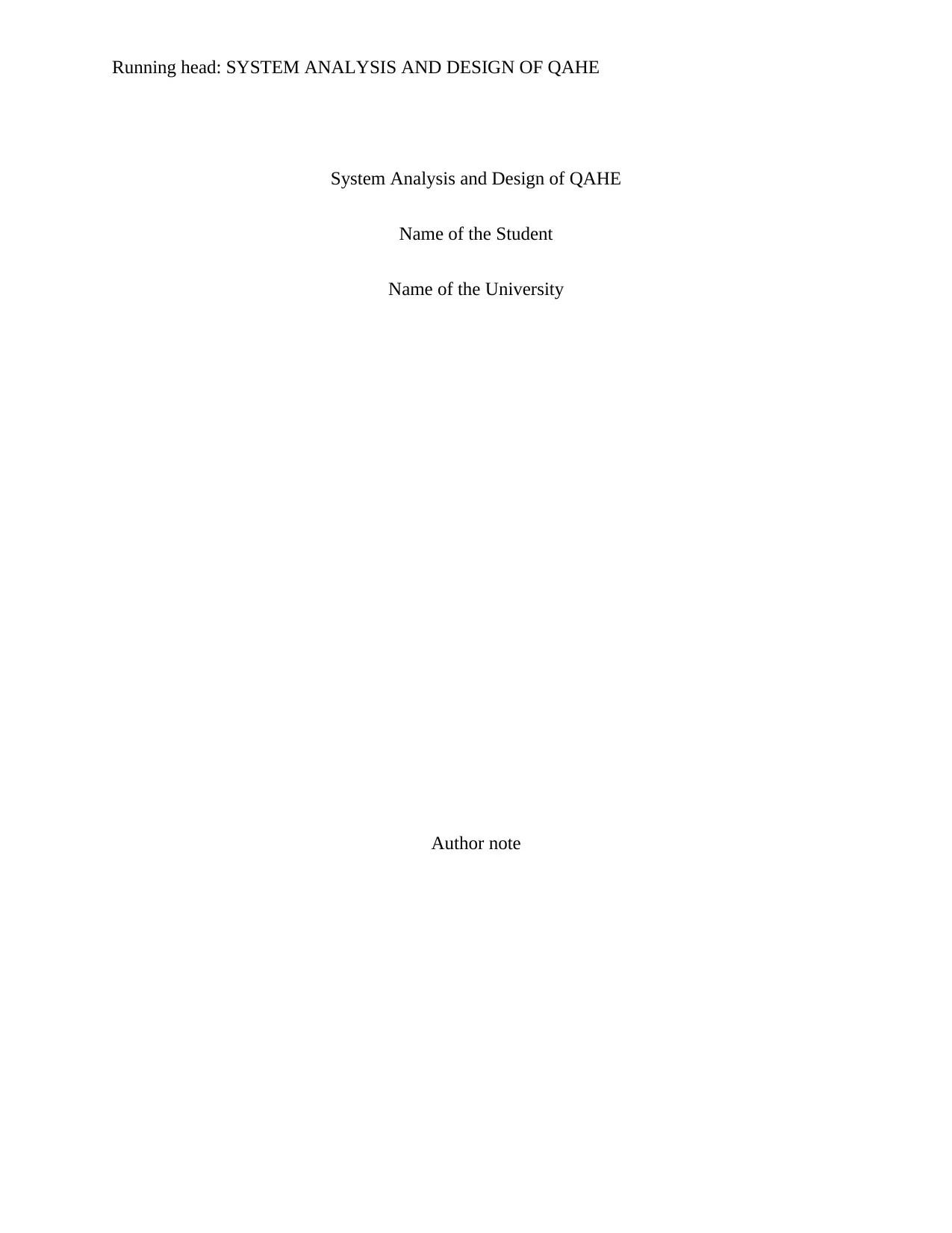
Running head: SYSTEM ANALYSIS AND DESIGN OF QAHE
System Analysis and Design of QAHE
Name of the Student
Name of the University
Author note
System Analysis and Design of QAHE
Name of the Student
Name of the University
Author note
Paraphrase This Document
Need a fresh take? Get an instant paraphrase of this document with our AI Paraphraser
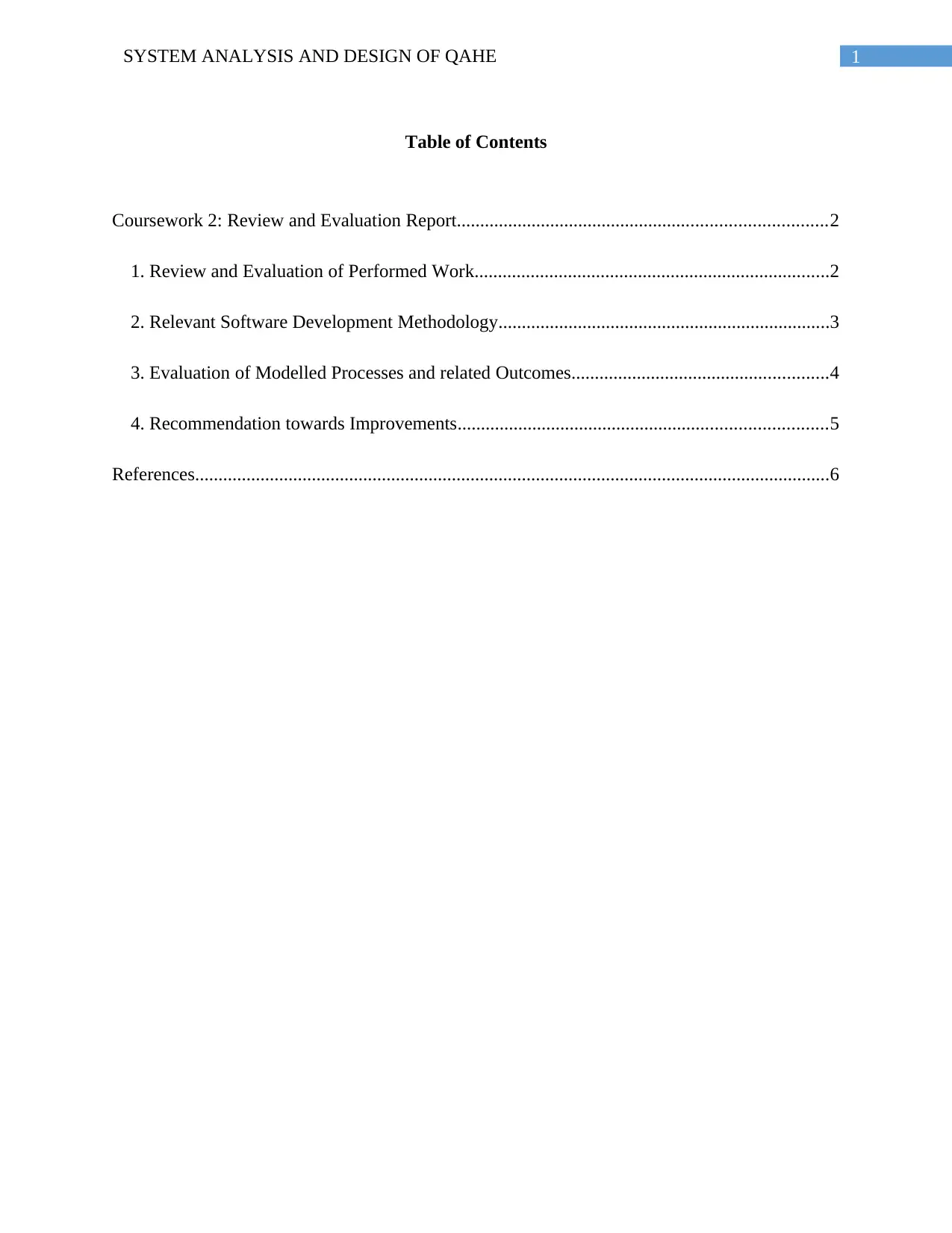
1SYSTEM ANALYSIS AND DESIGN OF QAHE
Table of Contents
Coursework 2: Review and Evaluation Report...............................................................................2
1. Review and Evaluation of Performed Work............................................................................2
2. Relevant Software Development Methodology.......................................................................3
3. Evaluation of Modelled Processes and related Outcomes.......................................................4
4. Recommendation towards Improvements...............................................................................5
References........................................................................................................................................6
Table of Contents
Coursework 2: Review and Evaluation Report...............................................................................2
1. Review and Evaluation of Performed Work............................................................................2
2. Relevant Software Development Methodology.......................................................................3
3. Evaluation of Modelled Processes and related Outcomes.......................................................4
4. Recommendation towards Improvements...............................................................................5
References........................................................................................................................................6
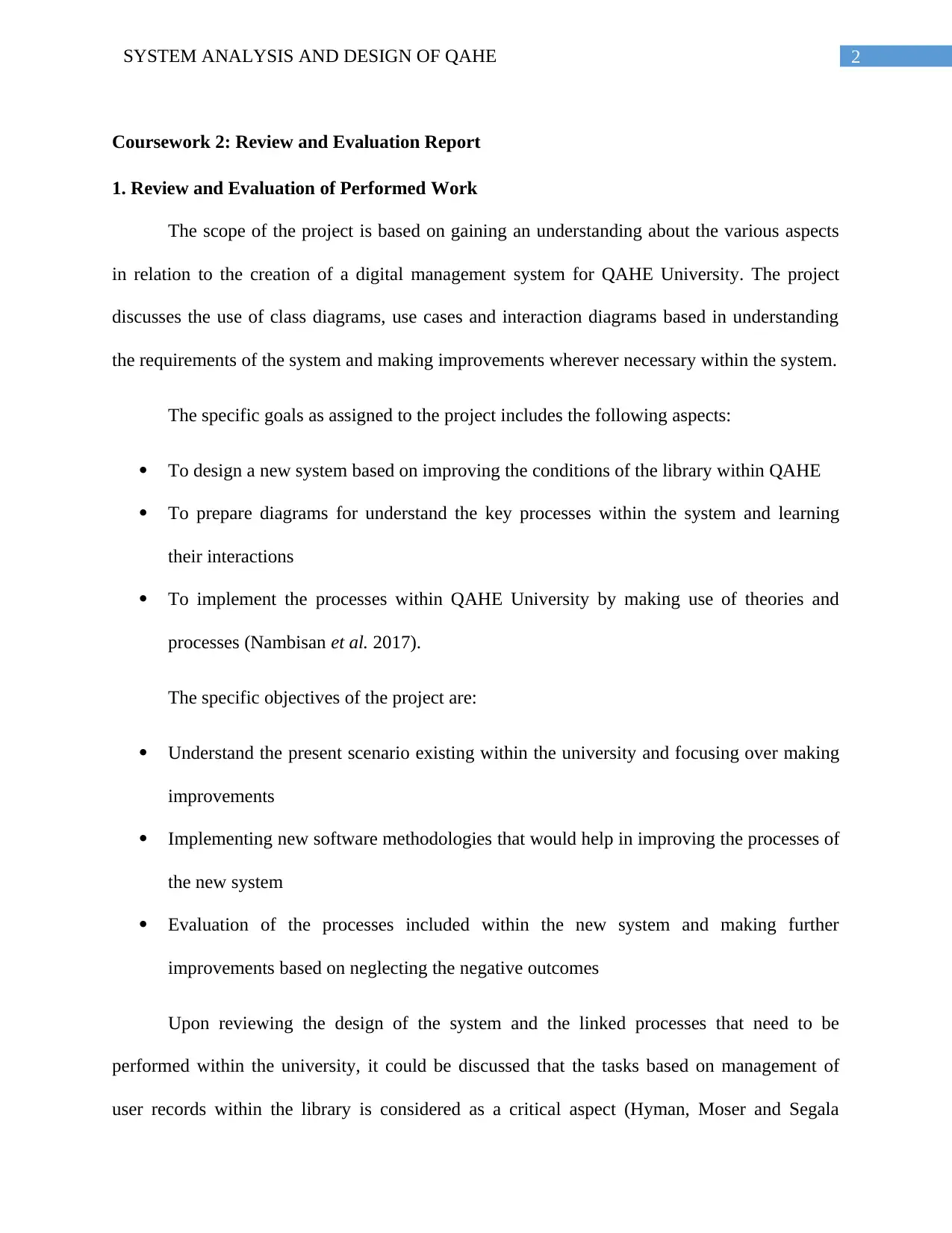
2SYSTEM ANALYSIS AND DESIGN OF QAHE
Coursework 2: Review and Evaluation Report
1. Review and Evaluation of Performed Work
The scope of the project is based on gaining an understanding about the various aspects
in relation to the creation of a digital management system for QAHE University. The project
discusses the use of class diagrams, use cases and interaction diagrams based in understanding
the requirements of the system and making improvements wherever necessary within the system.
The specific goals as assigned to the project includes the following aspects:
To design a new system based on improving the conditions of the library within QAHE
To prepare diagrams for understand the key processes within the system and learning
their interactions
To implement the processes within QAHE University by making use of theories and
processes (Nambisan et al. 2017).
The specific objectives of the project are:
Understand the present scenario existing within the university and focusing over making
improvements
Implementing new software methodologies that would help in improving the processes of
the new system
Evaluation of the processes included within the new system and making further
improvements based on neglecting the negative outcomes
Upon reviewing the design of the system and the linked processes that need to be
performed within the university, it could be discussed that the tasks based on management of
user records within the library is considered as a critical aspect (Hyman, Moser and Segala
Coursework 2: Review and Evaluation Report
1. Review and Evaluation of Performed Work
The scope of the project is based on gaining an understanding about the various aspects
in relation to the creation of a digital management system for QAHE University. The project
discusses the use of class diagrams, use cases and interaction diagrams based in understanding
the requirements of the system and making improvements wherever necessary within the system.
The specific goals as assigned to the project includes the following aspects:
To design a new system based on improving the conditions of the library within QAHE
To prepare diagrams for understand the key processes within the system and learning
their interactions
To implement the processes within QAHE University by making use of theories and
processes (Nambisan et al. 2017).
The specific objectives of the project are:
Understand the present scenario existing within the university and focusing over making
improvements
Implementing new software methodologies that would help in improving the processes of
the new system
Evaluation of the processes included within the new system and making further
improvements based on neglecting the negative outcomes
Upon reviewing the design of the system and the linked processes that need to be
performed within the university, it could be discussed that the tasks based on management of
user records within the library is considered as a critical aspect (Hyman, Moser and Segala
⊘ This is a preview!⊘
Do you want full access?
Subscribe today to unlock all pages.

Trusted by 1+ million students worldwide
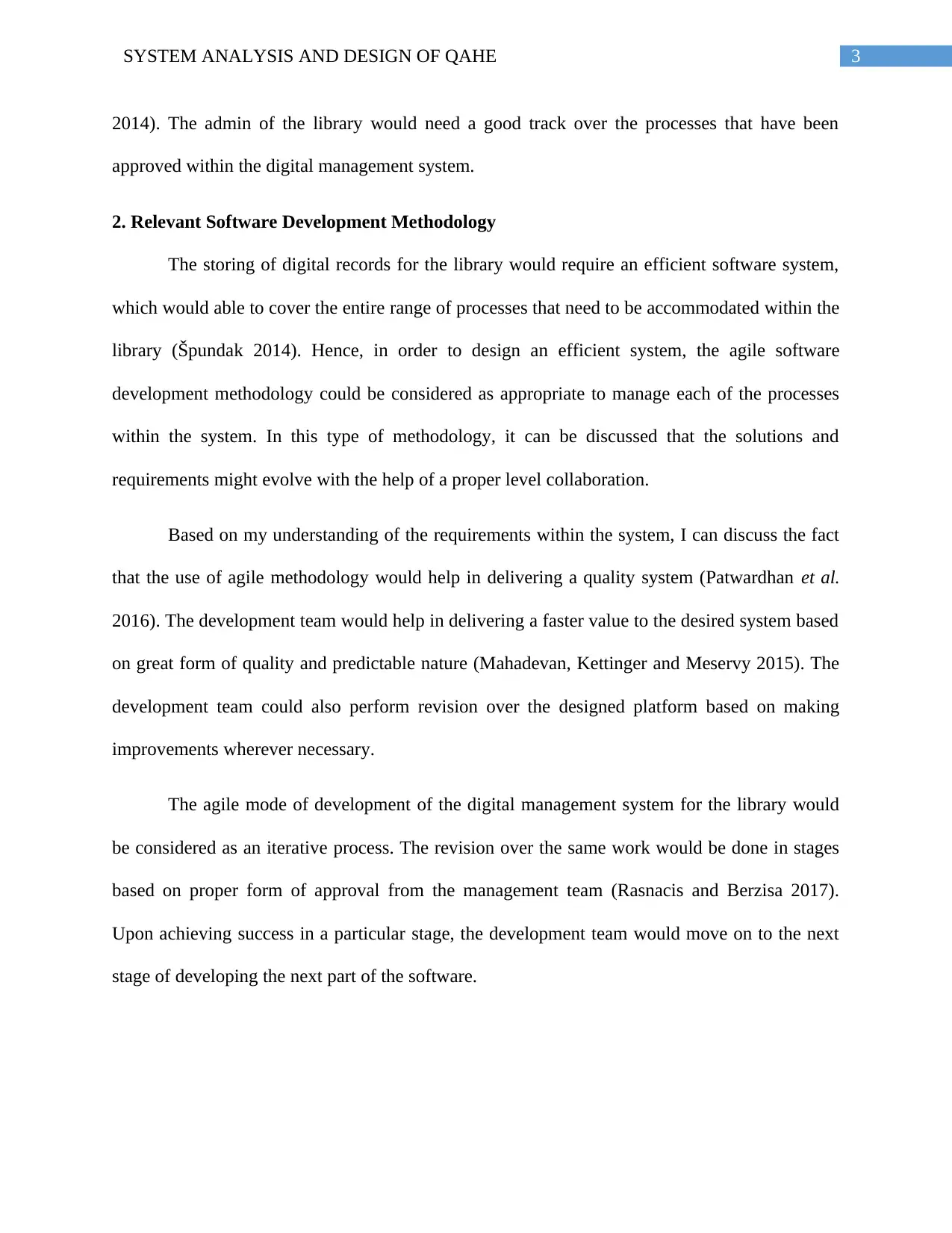
3SYSTEM ANALYSIS AND DESIGN OF QAHE
2014). The admin of the library would need a good track over the processes that have been
approved within the digital management system.
2. Relevant Software Development Methodology
The storing of digital records for the library would require an efficient software system,
which would able to cover the entire range of processes that need to be accommodated within the
library (Špundak 2014). Hence, in order to design an efficient system, the agile software
development methodology could be considered as appropriate to manage each of the processes
within the system. In this type of methodology, it can be discussed that the solutions and
requirements might evolve with the help of a proper level collaboration.
Based on my understanding of the requirements within the system, I can discuss the fact
that the use of agile methodology would help in delivering a quality system (Patwardhan et al.
2016). The development team would help in delivering a faster value to the desired system based
on great form of quality and predictable nature (Mahadevan, Kettinger and Meservy 2015). The
development team could also perform revision over the designed platform based on making
improvements wherever necessary.
The agile mode of development of the digital management system for the library would
be considered as an iterative process. The revision over the same work would be done in stages
based on proper form of approval from the management team (Rasnacis and Berzisa 2017).
Upon achieving success in a particular stage, the development team would move on to the next
stage of developing the next part of the software.
2014). The admin of the library would need a good track over the processes that have been
approved within the digital management system.
2. Relevant Software Development Methodology
The storing of digital records for the library would require an efficient software system,
which would able to cover the entire range of processes that need to be accommodated within the
library (Špundak 2014). Hence, in order to design an efficient system, the agile software
development methodology could be considered as appropriate to manage each of the processes
within the system. In this type of methodology, it can be discussed that the solutions and
requirements might evolve with the help of a proper level collaboration.
Based on my understanding of the requirements within the system, I can discuss the fact
that the use of agile methodology would help in delivering a quality system (Patwardhan et al.
2016). The development team would help in delivering a faster value to the desired system based
on great form of quality and predictable nature (Mahadevan, Kettinger and Meservy 2015). The
development team could also perform revision over the designed platform based on making
improvements wherever necessary.
The agile mode of development of the digital management system for the library would
be considered as an iterative process. The revision over the same work would be done in stages
based on proper form of approval from the management team (Rasnacis and Berzisa 2017).
Upon achieving success in a particular stage, the development team would move on to the next
stage of developing the next part of the software.
Paraphrase This Document
Need a fresh take? Get an instant paraphrase of this document with our AI Paraphraser
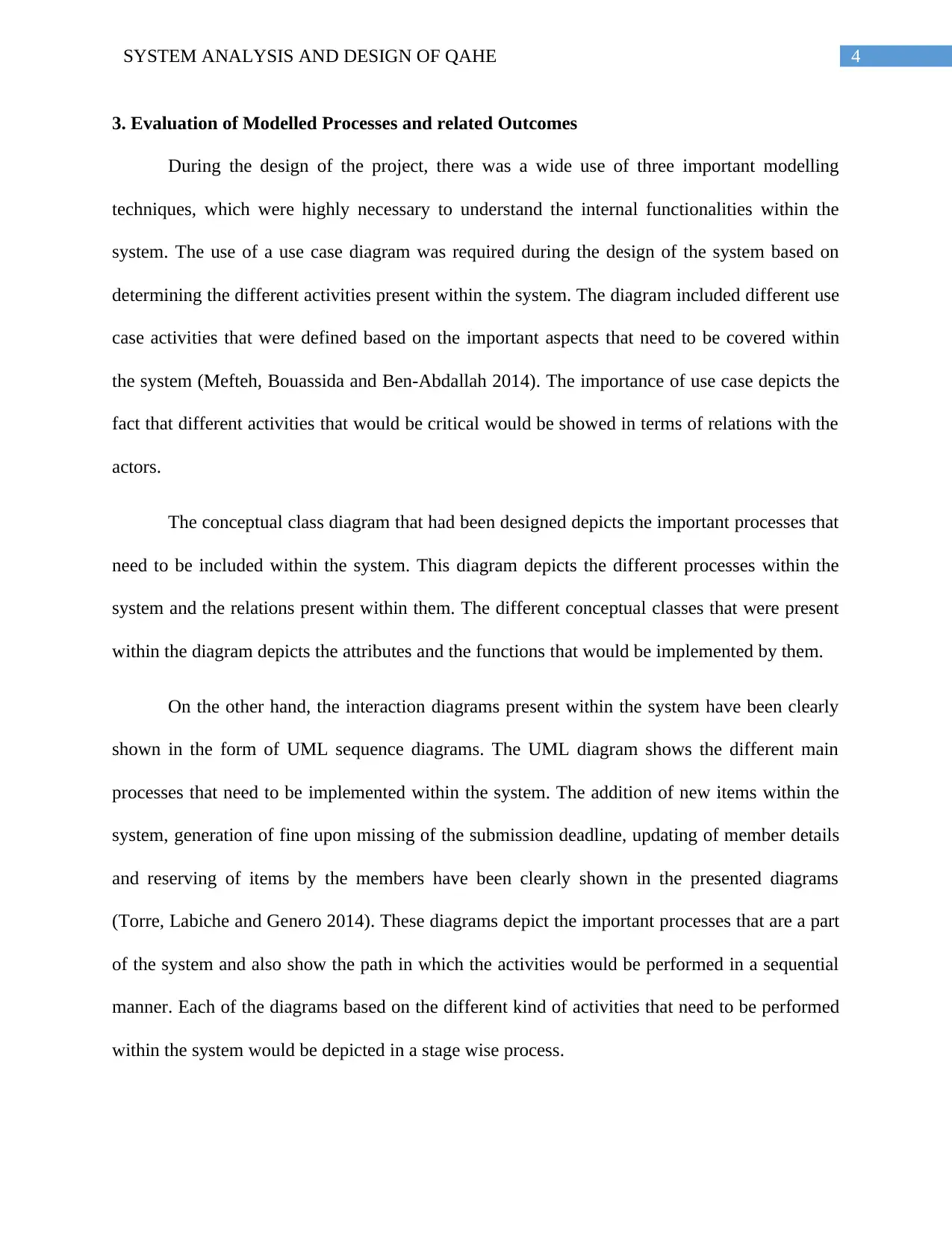
4SYSTEM ANALYSIS AND DESIGN OF QAHE
3. Evaluation of Modelled Processes and related Outcomes
During the design of the project, there was a wide use of three important modelling
techniques, which were highly necessary to understand the internal functionalities within the
system. The use of a use case diagram was required during the design of the system based on
determining the different activities present within the system. The diagram included different use
case activities that were defined based on the important aspects that need to be covered within
the system (Mefteh, Bouassida and Ben-Abdallah 2014). The importance of use case depicts the
fact that different activities that would be critical would be showed in terms of relations with the
actors.
The conceptual class diagram that had been designed depicts the important processes that
need to be included within the system. This diagram depicts the different processes within the
system and the relations present within them. The different conceptual classes that were present
within the diagram depicts the attributes and the functions that would be implemented by them.
On the other hand, the interaction diagrams present within the system have been clearly
shown in the form of UML sequence diagrams. The UML diagram shows the different main
processes that need to be implemented within the system. The addition of new items within the
system, generation of fine upon missing of the submission deadline, updating of member details
and reserving of items by the members have been clearly shown in the presented diagrams
(Torre, Labiche and Genero 2014). These diagrams depict the important processes that are a part
of the system and also show the path in which the activities would be performed in a sequential
manner. Each of the diagrams based on the different kind of activities that need to be performed
within the system would be depicted in a stage wise process.
3. Evaluation of Modelled Processes and related Outcomes
During the design of the project, there was a wide use of three important modelling
techniques, which were highly necessary to understand the internal functionalities within the
system. The use of a use case diagram was required during the design of the system based on
determining the different activities present within the system. The diagram included different use
case activities that were defined based on the important aspects that need to be covered within
the system (Mefteh, Bouassida and Ben-Abdallah 2014). The importance of use case depicts the
fact that different activities that would be critical would be showed in terms of relations with the
actors.
The conceptual class diagram that had been designed depicts the important processes that
need to be included within the system. This diagram depicts the different processes within the
system and the relations present within them. The different conceptual classes that were present
within the diagram depicts the attributes and the functions that would be implemented by them.
On the other hand, the interaction diagrams present within the system have been clearly
shown in the form of UML sequence diagrams. The UML diagram shows the different main
processes that need to be implemented within the system. The addition of new items within the
system, generation of fine upon missing of the submission deadline, updating of member details
and reserving of items by the members have been clearly shown in the presented diagrams
(Torre, Labiche and Genero 2014). These diagrams depict the important processes that are a part
of the system and also show the path in which the activities would be performed in a sequential
manner. Each of the diagrams based on the different kind of activities that need to be performed
within the system would be depicted in a stage wise process.
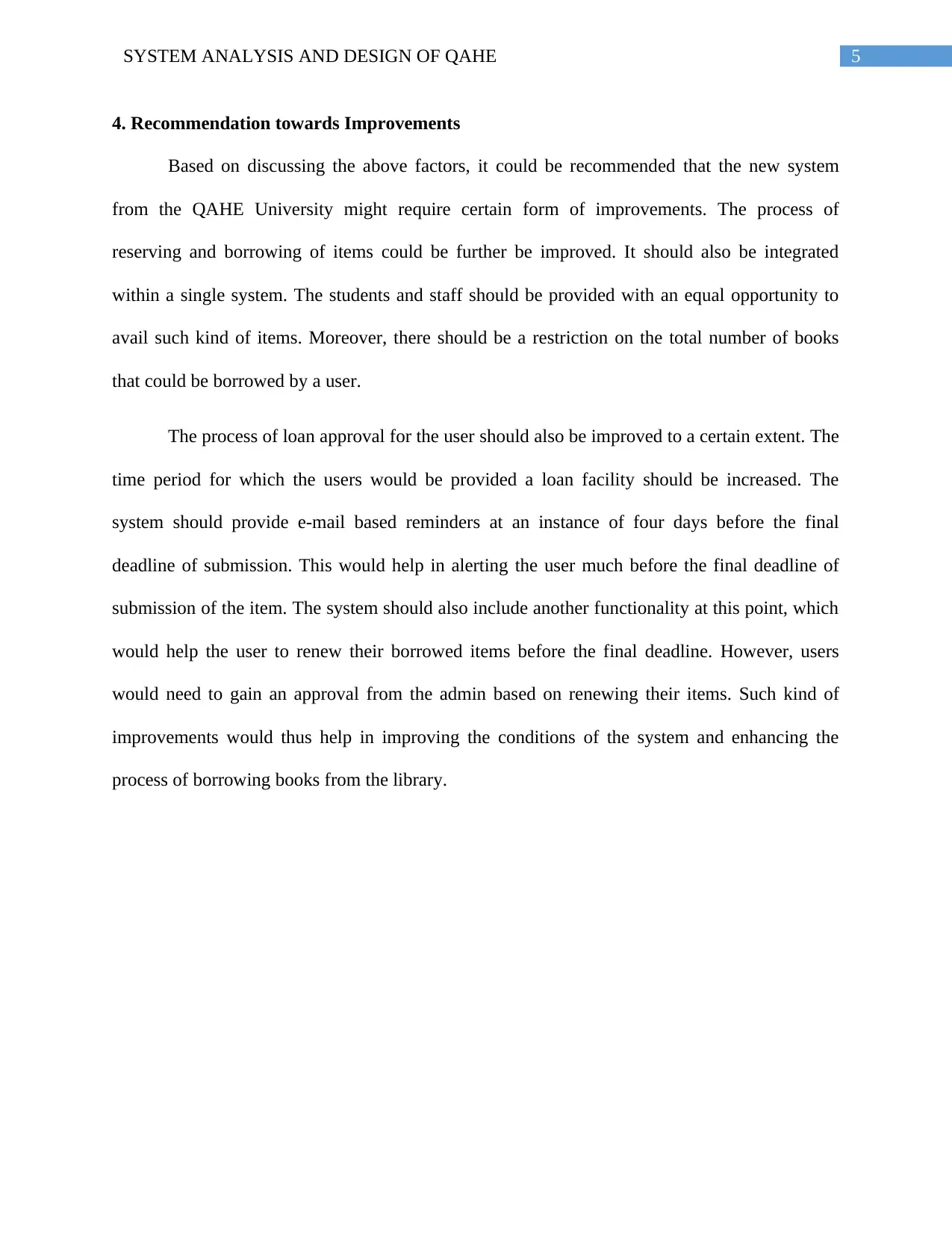
5SYSTEM ANALYSIS AND DESIGN OF QAHE
4. Recommendation towards Improvements
Based on discussing the above factors, it could be recommended that the new system
from the QAHE University might require certain form of improvements. The process of
reserving and borrowing of items could be further be improved. It should also be integrated
within a single system. The students and staff should be provided with an equal opportunity to
avail such kind of items. Moreover, there should be a restriction on the total number of books
that could be borrowed by a user.
The process of loan approval for the user should also be improved to a certain extent. The
time period for which the users would be provided a loan facility should be increased. The
system should provide e-mail based reminders at an instance of four days before the final
deadline of submission. This would help in alerting the user much before the final deadline of
submission of the item. The system should also include another functionality at this point, which
would help the user to renew their borrowed items before the final deadline. However, users
would need to gain an approval from the admin based on renewing their items. Such kind of
improvements would thus help in improving the conditions of the system and enhancing the
process of borrowing books from the library.
4. Recommendation towards Improvements
Based on discussing the above factors, it could be recommended that the new system
from the QAHE University might require certain form of improvements. The process of
reserving and borrowing of items could be further be improved. It should also be integrated
within a single system. The students and staff should be provided with an equal opportunity to
avail such kind of items. Moreover, there should be a restriction on the total number of books
that could be borrowed by a user.
The process of loan approval for the user should also be improved to a certain extent. The
time period for which the users would be provided a loan facility should be increased. The
system should provide e-mail based reminders at an instance of four days before the final
deadline of submission. This would help in alerting the user much before the final deadline of
submission of the item. The system should also include another functionality at this point, which
would help the user to renew their borrowed items before the final deadline. However, users
would need to gain an approval from the admin based on renewing their items. Such kind of
improvements would thus help in improving the conditions of the system and enhancing the
process of borrowing books from the library.
⊘ This is a preview!⊘
Do you want full access?
Subscribe today to unlock all pages.

Trusted by 1+ million students worldwide
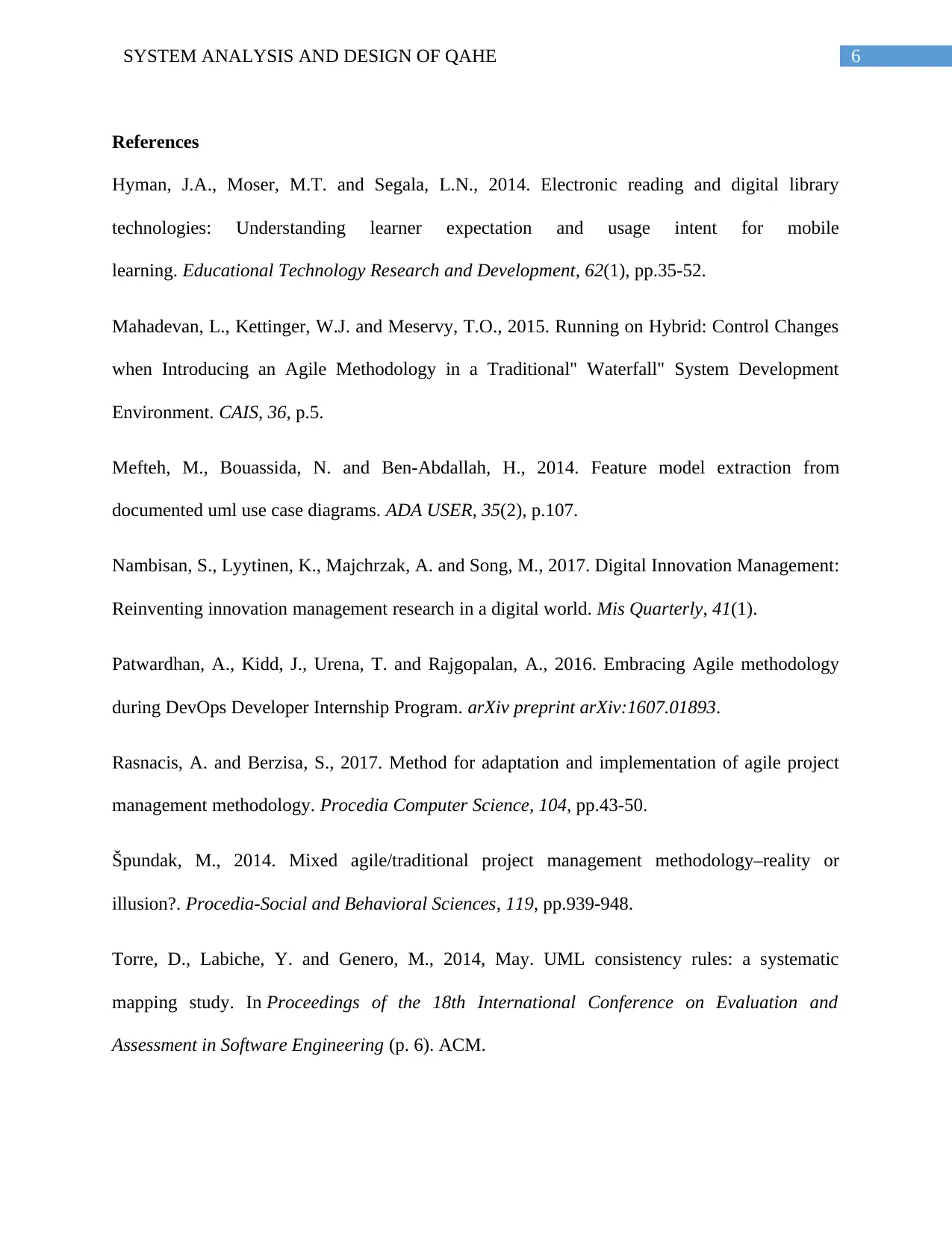
6SYSTEM ANALYSIS AND DESIGN OF QAHE
References
Hyman, J.A., Moser, M.T. and Segala, L.N., 2014. Electronic reading and digital library
technologies: Understanding learner expectation and usage intent for mobile
learning. Educational Technology Research and Development, 62(1), pp.35-52.
Mahadevan, L., Kettinger, W.J. and Meservy, T.O., 2015. Running on Hybrid: Control Changes
when Introducing an Agile Methodology in a Traditional" Waterfall" System Development
Environment. CAIS, 36, p.5.
Mefteh, M., Bouassida, N. and Ben-Abdallah, H., 2014. Feature model extraction from
documented uml use case diagrams. ADA USER, 35(2), p.107.
Nambisan, S., Lyytinen, K., Majchrzak, A. and Song, M., 2017. Digital Innovation Management:
Reinventing innovation management research in a digital world. Mis Quarterly, 41(1).
Patwardhan, A., Kidd, J., Urena, T. and Rajgopalan, A., 2016. Embracing Agile methodology
during DevOps Developer Internship Program. arXiv preprint arXiv:1607.01893.
Rasnacis, A. and Berzisa, S., 2017. Method for adaptation and implementation of agile project
management methodology. Procedia Computer Science, 104, pp.43-50.
Špundak, M., 2014. Mixed agile/traditional project management methodology–reality or
illusion?. Procedia-Social and Behavioral Sciences, 119, pp.939-948.
Torre, D., Labiche, Y. and Genero, M., 2014, May. UML consistency rules: a systematic
mapping study. In Proceedings of the 18th International Conference on Evaluation and
Assessment in Software Engineering (p. 6). ACM.
References
Hyman, J.A., Moser, M.T. and Segala, L.N., 2014. Electronic reading and digital library
technologies: Understanding learner expectation and usage intent for mobile
learning. Educational Technology Research and Development, 62(1), pp.35-52.
Mahadevan, L., Kettinger, W.J. and Meservy, T.O., 2015. Running on Hybrid: Control Changes
when Introducing an Agile Methodology in a Traditional" Waterfall" System Development
Environment. CAIS, 36, p.5.
Mefteh, M., Bouassida, N. and Ben-Abdallah, H., 2014. Feature model extraction from
documented uml use case diagrams. ADA USER, 35(2), p.107.
Nambisan, S., Lyytinen, K., Majchrzak, A. and Song, M., 2017. Digital Innovation Management:
Reinventing innovation management research in a digital world. Mis Quarterly, 41(1).
Patwardhan, A., Kidd, J., Urena, T. and Rajgopalan, A., 2016. Embracing Agile methodology
during DevOps Developer Internship Program. arXiv preprint arXiv:1607.01893.
Rasnacis, A. and Berzisa, S., 2017. Method for adaptation and implementation of agile project
management methodology. Procedia Computer Science, 104, pp.43-50.
Špundak, M., 2014. Mixed agile/traditional project management methodology–reality or
illusion?. Procedia-Social and Behavioral Sciences, 119, pp.939-948.
Torre, D., Labiche, Y. and Genero, M., 2014, May. UML consistency rules: a systematic
mapping study. In Proceedings of the 18th International Conference on Evaluation and
Assessment in Software Engineering (p. 6). ACM.
1 out of 7
Related Documents
Your All-in-One AI-Powered Toolkit for Academic Success.
+13062052269
info@desklib.com
Available 24*7 on WhatsApp / Email
![[object Object]](/_next/static/media/star-bottom.7253800d.svg)
Unlock your academic potential
Copyright © 2020–2025 A2Z Services. All Rights Reserved. Developed and managed by ZUCOL.



